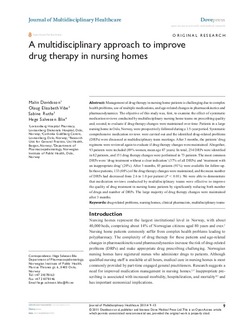| dc.contributor.author | Davidsson, Malin | |
| dc.contributor.author | Vibe, Olaug Elisabeth | |
| dc.contributor.author | Ruths, Sabine | |
| dc.contributor.author | Blix, Hege Salvesen | |
| dc.date.accessioned | 2017-06-07T12:41:06Z | |
| dc.date.available | 2017-06-07T12:41:06Z | |
| dc.date.issued | 2011 | |
| dc.identifier.citation | Davidsson, M., Vibe, O.E., Ruths, S. & Blix, H.S. (2011) A multidisciplinary approach to improve drug therapy in nursing homes. Journal of Multidisciplinary Healthcare, 4, s. 9-13. | |
| dc.identifier.uri | http://hdl.handle.net/11250/2445186 | |
| dc.description | Beskriver en intervensjonsstudie hvor hensikten var å undersøke effekten av legemiddelgjennomganger i sykehjem, og å se om endringene ble opprettholdt over tid. | |
| dc.description.abstract | Management of drug therapy in nursing home patients is challenging due to complex health problems, use of multiple medications, and age-related changes in pharmacokinetics and pharmacodynamics. The objective of this study was, first, to examine the effect of systematic medication reviews conducted by multidisciplinary nursing home teams on prescribing quality and, second, to evaluate if drug therapy changes were maintained over time. Patients in a large nursing home in Oslo, Norway, were prospectively followed during a 1.5-year period. Systematic comprehensive medication reviews were carried out and the identified drug-related problems (DRPs) were discussed at multidisciplinary team meetings. After 3 months, the patients’ drug regimens were reviewed again to evaluate if drug therapy changes were maintained. Altogether, 93 patients were included (89% women, mean age 87 years). In total, 234 DRPs were identified in 82 patients, and 151 drug therapy changes were performed in 73 patients. The most common DRPs were ‘drug treatment without a clear indication’ (37% of all DRPs) and ‘treatment with an inappropriate drug’ (20%). After 3 months, 85 patients (91%) were available for follow-up. In these patients, 133 (88%) of the drug therapy changes were maintained, and the mean number of DRPs had decreased from 2.6 to 1.0 per patient (P , 0.01). We were able to demonstrate that medication reviews conducted by multidisciplinary teams were effective to improve the quality of drug treatment in nursing home patients by significantly reducing both number of drugs and number of DRPs. The large majority of drug therapy changes were maintained after 3 months. | |
| dc.language.iso | eng | |
| dc.rights | Navngivelse-Ikkekommersiell 4.0 Internasjonal | |
| dc.rights.uri | http://creativecommons.org/licenses/by-nc/4.0/deed.no | |
| dc.subject | pasientsikkerhet | |
| dc.subject | legemiddel | |
| dc.subject | legemiddelbruk | |
| dc.subject | legemiddelliste | |
| dc.subject | legemiddelforskrivning | |
| dc.subject | legemiddelgjennomgang | |
| dc.subject | legemiddelrelaterte problemer | |
| dc.subject | legemiddelinteraksjoner | |
| dc.subject | uhensiktsmessig legemiddelbruk | |
| dc.subject | tverrfaglig samarbeid | |
| dc.subject | farmasøyt | |
| dc.subject | sykepleier | |
| dc.subject | lege | |
| dc.subject | fastlege | |
| dc.subject | sykehjemslege | |
| dc.subject | sykehjem | |
| dc.subject | dokumentasjon | |
| dc.subject | elektronisk pasientjournal | |
| dc.subject | pasientjournal | |
| dc.subject | intervensjon | |
| dc.subject | journalgranskning | |
| dc.subject | kartlegging | |
| dc.subject | screening | |
| dc.subject | eldre | |
| dc.subject | Oslo | |
| dc.subject | Norge | |
| dc.title | A multidisciplinary approach to improve drug therapy in nursing homes | |
| dc.type | Journal article | |
| dc.rights.holder | Blix, Hege Salvesen | |
| dc.source.volume | 4 | |
| dc.source.journal | Journal of Multidisciplinary Healthcare | |
| dc.identifier.doi | 10.2147/JMDH.S15773 | |

